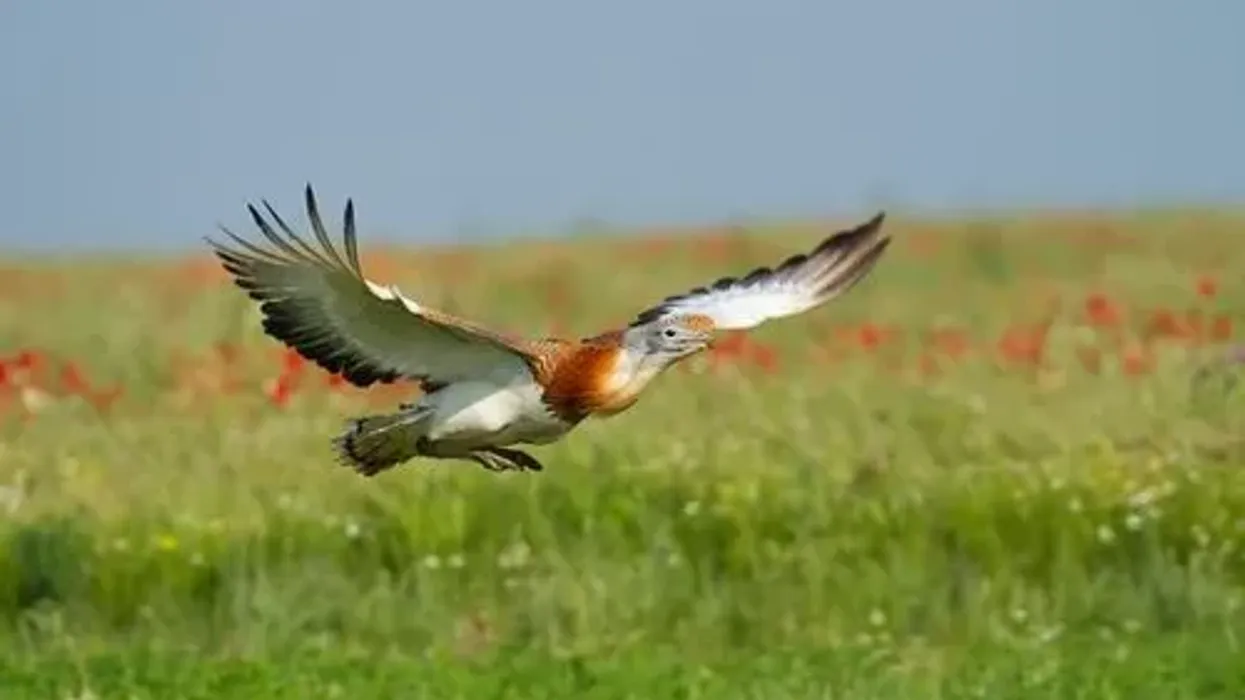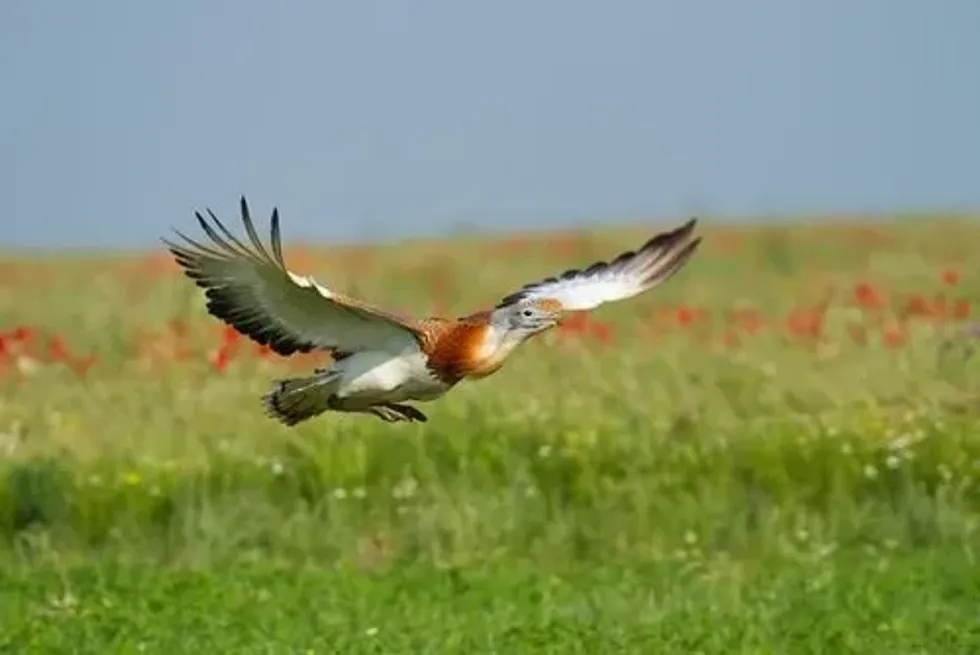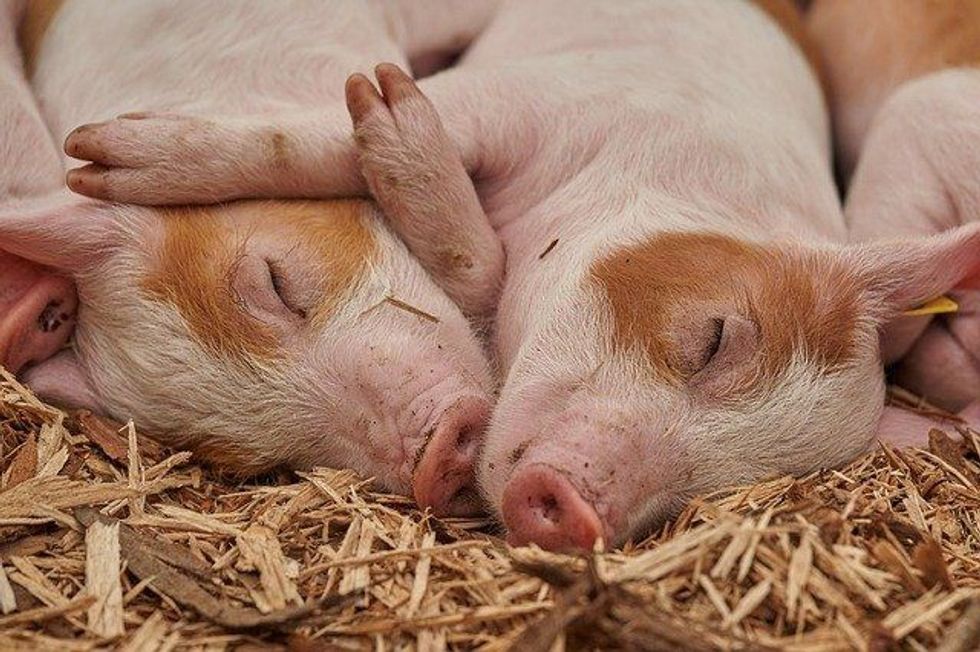Bustards are land-dwelling birds of medium-large size, that are often referred to as the world's heaviest flying species of bird. They have a length ranging from 16-59 in (40-150 cm) and weight anywhere between the range of 1-42.2 lb (0.45-19 kg).
They are a part of the Otididae family. There are currently 26 recognized bustard species in the world with the two largest species being the great bustard (Otis tarda) and the Kori bustard (Ardeotis kori).
The evolution of bustards dates back to 30 million years ago in Africa.
They spread into Australia and Eurasia from Africa and today they live mostly in arid grassland areas. Bustards are omnivorous birds that consume seeds, leaves, fruits, buds, tiny vertebrates, and invertebrates.
These birds prefer running and walking over flying, but during flight, they display large wide wings with fingered wingtips and stunning patterns. Many bustards have unique mating behaviors, like raising intricate feathered crests or expanding throat sacs.
If you enjoyed reading about the amazing bustard, why not read our interesting animal facts about the Kori bustard and the ostrich as well?
Bustard Interesting Facts
What type of animal is a bustard?
Bustards are huge terrestrial game birds belonging to the family Otididae and the kingdom Animalia. The word 'bustard' is a mix of Old French 'bistarde' and 'oustarde', both of which come from the Latin 'avis tarda', which means 'slow bird'.
Because bustards are swift runners, their name remains a mystery.
They have 26 recognized species and they are medium-large in size, with strong long legs that are apt for walking and running. They are omnivorous birds found across Africa, Europe, Asia, and Australia in mainly open habitats and they are often described as the heaviest flying birds in the world.
What class of animal does a bustard belong to?
The magnificent bustard bird belongs to the class Aves and the Otididae family.
How many bustards are there in the world?
The estimated total of all bustards in the world is not yet known, but there are some species whose population trend has been declining. Populations in certain areas have been declining majorly due to hunting and habitat degradation.
As per the IUCN Red List, the great bustard (Otis tarda) has a population of approximately 44,000-57,000. The state of Rajasthan in India has the largest density of Great Indian bustards (Ardeotis nigriceps), estimated at over 175 birds. The Great Indian Bustard is the heaviest bird in India.
Where does a bustard live?
Bustards are mostly found in grasslands with little foliage, where they can look over a long range of distances. Bustards can also often be seen in fields.
A few bustards prefer slightly forested regions. Bustards like to stay on the ground rather than sit on branches, therefore they don't require any hind toes. When fleeing away from predators, their huge wings come in handy.
What is a bustard's habitat?
Bustards choose to reside in open places to easily spot any incoming threat. If they spot an outsider near them, they back off stealthily to remain unobserved.
Therefore, they are often seen living in lowland regions. Bustard birds can be found throughout Asia, Australia, Africa, and Europe. Many bustard species are migratory and move from their breeding grounds to their winter grounds in cold weather.
Males develop a social hierarchy in the winter season, participating in aggressive fights that often involve stabbing other males in the head and neck. These fights may occasionally inflict significant harm, which is a characteristic of bustard behavior.
Who do bustards live with?
After the mating season, bustards are quite sociable birds, but in open areas, they are cautious and tough to approach. Bustards can live alone or they can be quite sociable. Small bustards form groups of lots of birds and live together, whereas bustards that live in semi-desert environments usually prefer to be alone.
How long does a bustard live?
The lifespan of all bustards on average is 10-15 years. Great bustards specifically live for around 10 years on average, though some have been known to survive for up to 15 years or more. The life expectancy of wild Kori bustards is unknown, although a captive Kori bustard (Ardeotis kori) bird can live as long as 26-28 years!
How do they reproduce?
Bustards reproduce in their natural environment during monsoons. To impress females, males go through elaborate courtship rituals called 'lek' throughout the breeding season. Males have unique breeding plumage that they display to lure females during the breeding season.
They also inflate their throat sacs as part of the display. The adult male does not assist in nest-building, egg incubation, or in the nourishment of chicks. The mother takes care of all that alone.
As they build their nests on the ground, their eggs and chicks are frequently preyed upon. Females lay one to six eggs and, after 20-25 days, the eggs hatch, bringing the chicks into the world.
The chicks of a bustard hatch at an advanced phase of development. Their chicks can move quickly after hatching within a small number of hours! The female bird takes care of these chicks alone.
What is their conservation status?
Four of the 26 bustard species are listed as Endangered, while six are classified as Near Threatened. The majority of other types of bustards are declining slowly as well.
Hunting and habitat degradation are the main threats to bustards. In 1832, the last bustard bird in Britain died. As a result, the breed is being reintroduced to the country through a batch of Russian bustard chicks.
These imported bustards hatched chicks in 2010 when two great bustard young birds were born in Britain. These were the first bustards in the country after 170 years!
Bustard Fun Facts
What do bustards look like?
Bustards are sturdy birds with long necks and muscular legs. Their feet are apt for sprinting, with flat toes and large soles.
They just have three toes and their hind toe is absent. Their bills are even and short in size and their colors range from gray to chestnut with white or black underneath.
Male bustards have heavy chests along with bulging necks. Many bustards have a spotted pattern on top and are white, beige, or black underneath. There is a significant size difference between males and females.
Males in most bustard species are significantly bigger than females, measuring up to 30% longer and weighing up to twice as much. However, in the case of Floricans, the female is bigger and heavier than the male.
How cute are they?
They are magnificent birds that have a shy nature. However, the behavior of each bird varies by its species. Their characteristics, like their wide wingspan and patterned coat, are appealing to the eye.
How do they communicate?
A male communicates by roaring calls whilst showing its stunning feathers, spreading its tail, and springing.
How big is a bustard?
The great bustard (Otis tarda) is the largest European land bird, having a 4 ft (120 cm) length and an 8 ft (240 cm) wingspan. The little brown bustard (Eupodotis humilis) is the smallest species, measuring approximately 16 in (40 cm) in length and weighing approximately 1.3 lb (600 g) on average.
It is double the size of an average cockatoo.
Can a bustard fly?
Yes, bustards can fly. They are referred to as the world's heaviest flying birds although they prefer to walk or run over taking flight. They are also migratory birds who migrate to escape cold winters. Great bustards travel almost 1242 miles (2,000 km) throughout Asia during their migration season.
How much does a bustard weigh?
The great bustard (Otis tarda) is the most well-known bustard, the biggest European land bird, with males weighing up to 31 lb (14 kg).
What are the male and female names of the species?
There is no particular name for the males and females of the bustard bird species.
What would you call a baby bustard?
A baby bustard bird is known as a hatchling, chick, or fledgling.
What do they eat?
Bustards are omnivores, so they eat both plants and animals. Flowers, leaves, roots, bulbs, fruits, seeds, and branches make up the majority of most species' diets. They consume grasshoppers as well as beetles. Insects are a vital part of the diet during the breeding period.
Larger creatures, such as rodents and reptiles are occasionally eaten. The species which live in farmed regions eat crops regularly. It has been observed that their main predators are wolves and falcons.
Are they dangerous?
It is a shy bird that adjusts its behavior if a large number of people are around it. There hasn't been any particular interaction of significance between bustards and people.
Would they make a good pet?
No, they are wild birds that get nervous around humans. They are quite shy and thrive in the wild. However, despite this, they are being raised in captivity to increase their population.
Did you know...
This bird has an important role in some portions of their territory. Bustards perform an essential role in agriculture by consuming enormous amounts of pests.
When in flight, a great bustard is commonly referred to as a 'flying fortress'.
Types of bustard
There are 26 bustard species in the world including the buff crested bustard, the Nubian bustard, the black-bellied bustard, the Arabian bustard (Ardeotis arabs), the Kori bustard (Ardeotis kori), the great bustard (Otis tarda), and 20 more.
How fast is a bustard?
Their speed during migration is an estimated 29mph (48 kph). Their top speed is 49 mph (80 kph).
Here at Kidadl, we have carefully created lots of interesting family-friendly animal facts for everyone to discover! Learn more about some other birds including the red-footed booby or the red kite.
You can even occupy yourself at home by drawing one on our little bustard coloring pages.










